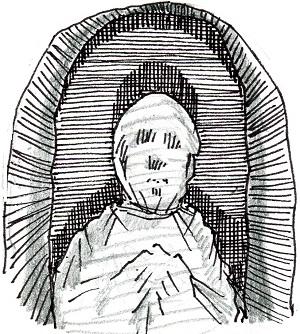
“Let us also go with him to die” (John 11:15).
Fifth Sunday of Lent
Ez 37:12-14; Ps 130; Rom 8:8-11; Jn 11:1-45
The story of the raising of Lazarus is a favorite Gospel for many funerals because it adds another powerful “sign” to the identity of Jesus, who tells Martha, “I AM the resurrection and the life.” This deeply theological story serves to initiate catechumens being baptized at the Holy Saturday vigil into Christian belief in resurrection. The story of Jesus, Martha and Mary walks us through the progress we must make to grasp the glory of the final sign of Jesus’ death and resurrection.
Lazarus is only resuscitated to his former life. As wonderful as that is, it only points to Jesus’ resurrection, a total transformation that breaks through the barriers of time and space and opens human destiny to eternal life with God. This gift is what we want for ourselves and our loved ones.
Death is a natural part of human life. We are not spared this experience, nor is Jesus, who does not avoid death. His powerful grief at the death of his friend Lazarus is real, not pretend. He goes to the depths of anguish and loss to deepen his human journey and to show his trust in God, who will not abandon him or us.
His own death on the cross completes the Incarnation, the even deeper mystery that Jesus is both human and divine, the bridge between our frail humanity and the glory of divine life that is the promise of our baptism. This redemptive bridge enables our passage through death to new life.
This is the faith of the church. Last Friday, March 24, the church commemorated the martyrdom of Saint Oscar Romero in 1980, along with the 80,000 victims of the Salvadoran civil war. Because we believe in the resurrection, we affirm that they stand in eternity with God’s Beloved Community to witness that love overcomes death, injustice and violence in history.
This is the faith of every parish community burying their dead, of every family grieving the loss of a loved one. We believe that they are now voices within the “cloud of witnesses” (Hebrews 12:1-2) that cheers the living church to keep the faith and demonstrate the presence of the risen Jesus active with them in the world.
The fourth Gospel’s story of the raising of Lazarus is a progressive exercise in faith for us and the catechumens being baptized at the vigil service. We are told that Jesus loved Martha, her sister Mary and their brother Lazarus. Despite this closeness, Jesus delays going to Lazarus until after his physical death. The disciple Thomas acknowledges this when he says, “Let us also go to die with him.”
When Jesus arrives, Martha and Mary express frustration with Jesus for his delay. Both say, “If you had been here, my brother would not have died.” Jesus repeatedly urges them to have faith that he can raise the dead, asking, “Do you believe this?” This exchange is repeated often in our experience of the death of a loved one, asking, “Where is God? Why did this death occur?”
When Jesus comes to the tomb and witnesses the grief of everyone gathered there, he breaks down and weeps. The Greek word that describes Jesus’ grief (embrimaomai) conveys the idea of gut-wrenching anguish, even anger. Lazarus was his friend, someone he loved, and his death moves Jesus profoundly. Witnesses say, “See how he loved him.”
The story makes clear that Lazarus is indeed dead. Martha knows that the corpse has already begun to decay when Jesus says, “Remove the stone.” He looks to heaven in intimate prayer, then cries out, “Lazarus, come forth!” Then, “Untie him and let him go.”
The resuscitation of Lazarus astonishes everyone, inspiring some to believe in Jesus. But, for the fourth Gospel, it is only pointing forward to the ultimate sign of faith that Jesus is from God and that what happens at his own death reveals his true identity as he fulfills Passover and empties his glory into the world. His crucifixion (“lifting up”) reveals his resurrection, his ascension, his final breath (Pentecost) and the outpouring of blood and water from his side that gives birth to the church by Eucharist and Baptism. This culminating revelation is the message to catechumens of the mystery they are now receiving.
Along with them and in the presence of our faith communities, we are invited to hear this same Word accessible to faith. Do we believe this? Then, remove the stone of doubt. Come forth into the light. Be free of the bonds of fear about death. Get ready for Holy Week. “Let us also go to die with him.”








